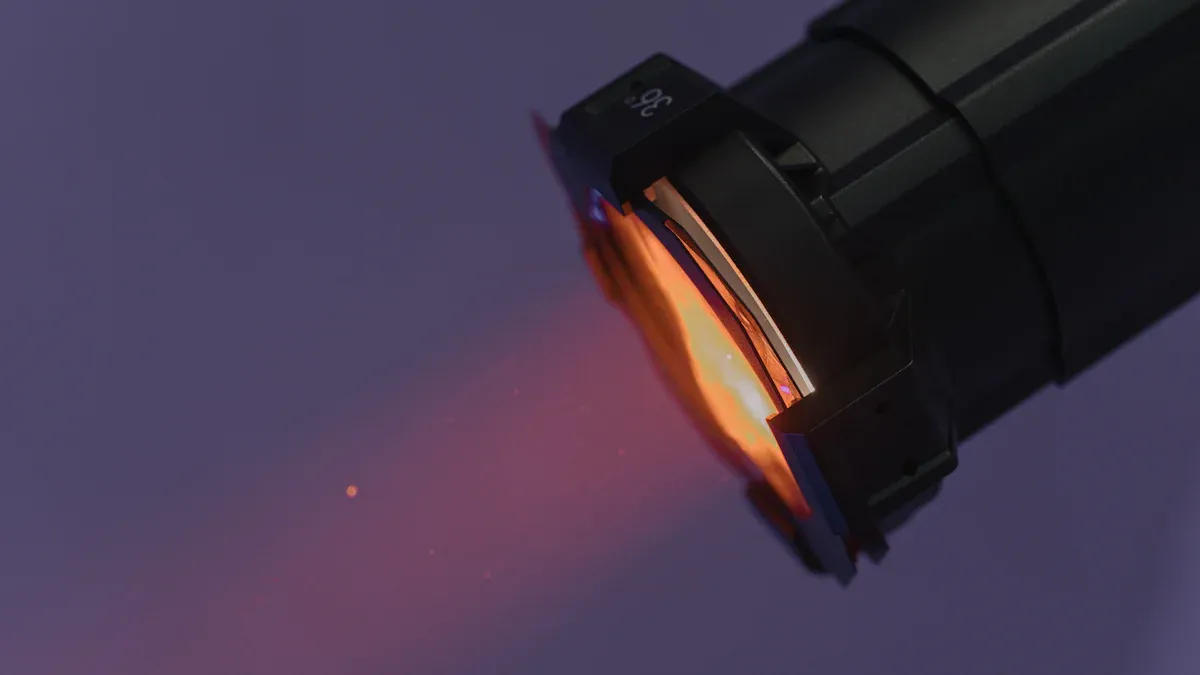How to Store Your Helius Flashlight Properly to Ensure Longevity

Proper storage and maintenance of your Helius flashlight prevent common issues like battery leakage, dim light, and internal corrosion. You should avoid extreme temperatures, keep it dry, and use a protective case. These steps protect the flashlight’s internal components and ensure it remains reliable for emergencies or everyday use.
Key Takeaways
Keep your Helius flashlight in a cool, dry spot. This stops harm from heat, cold, or wetness.
Take out the batteries if storing for a long time. This prevents leaks and makes batteries last longer.
Clean your flashlight often and check for any damage. This helps it work well and stay ready to use.
Why Proper Storage Matters
Risks of Improper Storage
Improper storage can significantly impact the performance and lifespan of your flashlight. When you leave your flashlight in a humid environment, moisture can corrode the metal contacts, reducing its efficiency. Storing it in extreme temperatures, whether too hot or too cold, can damage internal components and shorten battery life. For lithium batteries, improper storage accelerates performance deterioration. Excessive heat speeds up chemical reactions, causing batteries to deplete faster.
Failing to remove batteries during long-term storage can lead to leakage, which damages the flashlight’s internal parts. Over time, these issues compromise flashlight durability, leaving you with a device that may fail when you need it most. To avoid these problems, always follow correct storage practices, such as keeping your flashlight in a cool, dry place.
Benefits of Proper Storage for Flashlight Durability
Proper storage and maintenance ensure your Helius flashlight remains reliable and durable. Keeping your flashlight in a cool, dry location prevents corrosion and protects its internal components. A protective case shields it from dust, scratches, and accidental impacts, preserving its functionality. Removing batteries during extended storage prevents unintentional drainage, while discharging rechargeable batteries before storage enhances their longevity.
By following these steps, you not only extend the life of your flashlight but also maintain its performance. Regular maintenance, such as periodic checks and cleaning, further ensures your flashlight is always ready for use. Proper care safeguards your investment and guarantees your flashlight will serve you well for years to come.
Ideal Storage Conditions for Your Helius Flashlight

Temperature Considerations
Temperature plays a critical role in maintaining flashlight durability. Always store your Helius flashlight in a cool and dry place. Extreme heat can accelerate chemical reactions in batteries, causing them to deplete faster. On the other hand, freezing temperatures can damage internal components and reduce the lifespan of rechargeable batteries. For optimal performance, avoid leaving your flashlight in direct sunlight, near heaters, or in freezing outdoor gear compartments. Keeping it at room temperature ensures its internal circuitry and high-quality batteries remain intact.
Humidity Levels
Humidity can significantly impact your flashlight's performance and durability. Even though the Helius flashlight offers water resistance, prolonged exposure to moisture can still harm its internal components. Aim to store it in an environment with low humidity levels. A range of 30-45% humidity, which is comfortable for human habitation, works well for long-term storage. If you live in a humid area, consider using silica gel packs or a dehumidifier to keep the storage area dry. This simple step prevents corrosion and extends the life of your flashlight.
Placement and Positioning
Proper placement and positioning protect your flashlight from unnecessary wear and tear. Follow these best practices:
Avoid extreme temperatures by storing it in a cool and dry place.
Keep it dry to prevent moisture from affecting the batteries and internal circuitry.
Use a protective case to shield it from dust, scratches, and accidental impacts.
These steps ensure your flashlight remains in excellent condition. If you own outdoor gear, store the flashlight separately to avoid accidental damage. Proper positioning not only enhances flashlight durability but also ensures it’s ready for use whenever needed.
Preparing Your Flashlight for Storage
Cleaning the Flashlight
A clean and functional flashlight starts with regular cleaning. Dust, dirt, and fingerprints can accumulate on the lens, reducing light output. Use a soft, lint-free cloth to gently wipe the lens. Avoid abrasive materials that might scratch the surface. For stubborn smudges, apply a lens cleaning solution designed for optical surfaces. Pay attention to keeping the lens streak-free for optimal performance.
Don’t forget to clean the flashlight body as well. Wipe it down with a damp cloth to remove dirt and grime. If your Helius flashlight has water resistance, you can rinse it lightly under running water, but ensure it’s completely dry before storage. Regular cleaning not only improves performance but also enhances flashlight durability.
Removing and Storing Batteries
Proper battery maintenance is essential for flashlight storage. Always remove the batteries before storing your flashlight for extended periods. Leaving them inside can lead to several risks:
Battery Leakage: Acid from leaking batteries can corrode internal components.
Reduced Battery Life: Batteries may slowly discharge, shortening their runtime.
Malfunctioning Switches: Corrosion can disrupt contact between the battery and switch terminals.
Increased Fire Risk: Batteries can overheat or short-circuit, posing a fire hazard.
Store the batteries in a cool, dry place, away from direct sunlight or extreme temperatures. If you use rechargeable batteries, discharge them partially before storage to prolong their lifespan. Always choose the right batteries for your flashlight to ensure reliable performance.
Inspecting for Damage
Before storing your flashlight, inspect it for any signs of damage. Check the lens for cracks or scratches that could affect light output. Examine the battery compartment for corrosion or residue. Regularly cleaning the battery contacts can prevent buildup and ensure proper conductivity.
Inspect the flashlight body for dents or wear that might compromise its water resistance. If you notice any issues, address them promptly to avoid further damage. These essential tips for flashlight maintenance will keep your Helius flashlight ready for use and extend its lifespan.
Long-Term Storage Tips for Flashlight Maintenance

Using Protective Cases
A protective case is essential for maintaining flashlight durability during long-term storage. It shields your Helius flashlight from dust, scratches, and accidental impacts. When choosing a case, consider the material’s durability. For example:
Material | Durability Characteristics | Notes |
|---|---|---|
Aluminum | Less shock absorbent, can deform permanently under stress | Used in high-quality flashlights for premium feel and heat dissipation |
Plastic | Absorbs shock better, less prone to permanent deformation | More stable over time, but can melt under extreme temperatures |
Plastic cases are ideal for conserving battery life and protecting your flashlight from physical damage. Aluminum cases, while durable, may not absorb shocks as effectively. Select a case that suits your storage environment and usage needs to extend the lifespan of your flashlight.
Periodic Maintenance and Checks
Regular maintenance is crucial for ensuring your flashlight remains functional. Even during storage, periodic checks help you identify potential issues early. Follow these guidelines:
Clean your flashlight every six months if you use it infrequently.
Perform monthly check-ups if you use it daily.
Inspect rechargeable batteries for signs of wear or leakage.
During these checks, clean the lens and body to remove dust and grime. Ensure the battery compartment is free of corrosion. Regular maintenance not only keeps your flashlight ready for emergencies but also helps in maintaining flashlight durability over time.
Storing in a Safe Location
The location where you store your flashlight plays a significant role in its longevity. Choose a cool, dry place away from direct sunlight or extreme temperatures. Avoid storing it near outdoor gear that could cause accidental damage. A safe location prevents exposure to moisture, which can compromise water resistance and damage internal components.
For added protection, store your flashlight with high-quality batteries removed. This prevents leakage and helps conserve battery life. By taking these precautions, you ensure your flashlight remains reliable and ready for use whenever needed.
Common Mistakes to Avoid in Flashlight Maintenance
Leaving Batteries Inside
Leaving batteries inside your flashlight during long-term storage can lead to several issues. Over time, batteries may corrode and leak acid, causing irreversible damage to the internal components. You might notice signs like a white or greenish powder buildup, liquid residue, or even an unpleasant odor in the battery compartment. These are clear indicators of battery leakage.
Here are the most common problems caused by leaving batteries inside:
Battery Leakage: Acid leakage corrodes the flashlight's internal parts.
Reduced Battery Life: Batteries slowly discharge, shortening their runtime.
Malfunctioning Switches: Corrosion disrupts contact between the battery and switch terminals.
Increased Fire Risk: Batteries can overheat or short-circuit, posing a fire hazard.
To prevent these issues, always remove batteries if you don’t plan to use the flashlight for an extended period. Store them in a cool, dry place, ideally between 50 and 77°F. Using a battery caddy can help keep them secure and prevent short circuits.
Storing in Extreme Temperatures
Extreme temperatures can severely impact your flashlight's performance and durability. Cold temperatures reduce the runtime of lithium batteries and may cause moisture inside the flashlight to freeze, leading to short circuits. On the other hand, excessive heat accelerates battery degradation and can even cause bulbs to blow due to sudden temperature changes.
Avoid storing your flashlight in outdoor gear compartments exposed to freezing conditions or near heat sources like radiators. Instead, choose a location with stable, moderate temperatures to protect the flashlight's internal components and rechargeable batteries.
Neglecting Regular Maintenance
Skipping regular flashlight maintenance can compromise its reliability, especially during emergencies. A poorly maintained flashlight may fail to operate when you need it most, leading to safety risks.
Risk Type | Description |
|---|---|
A non-functional flashlight can leave you disoriented in emergencies. | |
Diminished Emergency Response | Emergency responders may face delays due to faulty flashlights. |
Financial Implications | Neglecting maintenance can lead to higher costs for repairs or replacements. |
To avoid these risks, clean your flashlight regularly and inspect it for damage. Wipe the exterior with a clean cloth, check the battery contacts for corrosion, and test the switch and light modes. These simple steps ensure your flashlight remains reliable and ready for use.
Proper storage and maintenance ensure your Helius flashlight remains reliable and durable. By keeping it in a cool, dry spot and removing batteries during long-term storage, you protect it from damage. Regular cleaning of the lens and body enhances performance, while inspecting the battery compartment prevents corrosion.
To maximize longevity, follow these steps:
Store your flashlight in a secure location to avoid physical damage.
Protect it from moisture to prevent internal component failure.
Use a protective case for added durability.
Additionally, remember to test your flashlight periodically. This ensures it functions properly and remains ready for emergencies. If your flashlight uses rechargeable batteries, manage charging cycles carefully to extend battery life. Proper charging practices, combined with regular maintenance, keep your flashlight operational for years.
Start implementing these tips today to keep your Helius flashlight in top condition. Whether for emergencies or daily use, proper care guarantees it will always perform when you need it most.
FAQ
How often should you clean your Helius flashlight?
You should clean your flashlight every six months if used occasionally. For daily use, clean it monthly to maintain optimal performance and durability.
Can you store rechargeable batteries inside the flashlight?
No, always remove rechargeable batteries before long-term storage. This prevents leakage and extends battery life. Follow proper charging techniques to maintain battery health.
What is the best way to store your flashlight during travel?
Use a durable protective case to shield your flashlight from impacts and dust. Store it in a cool, dry place to avoid damage from extreme temperatures.
See Also
Key Strategies for Keeping Your Flashlight in Top Shape
Explore the Helius Lantern: 200 Hours of Bright Camping Light
In-Depth Review of the Heliusworld Flashlight Performance
Reasons to Select Helius Flashlight for Everyday Carry Essentials
Helius Tactical Flashlight: Shedding Light on Your Outdoor Journeys
